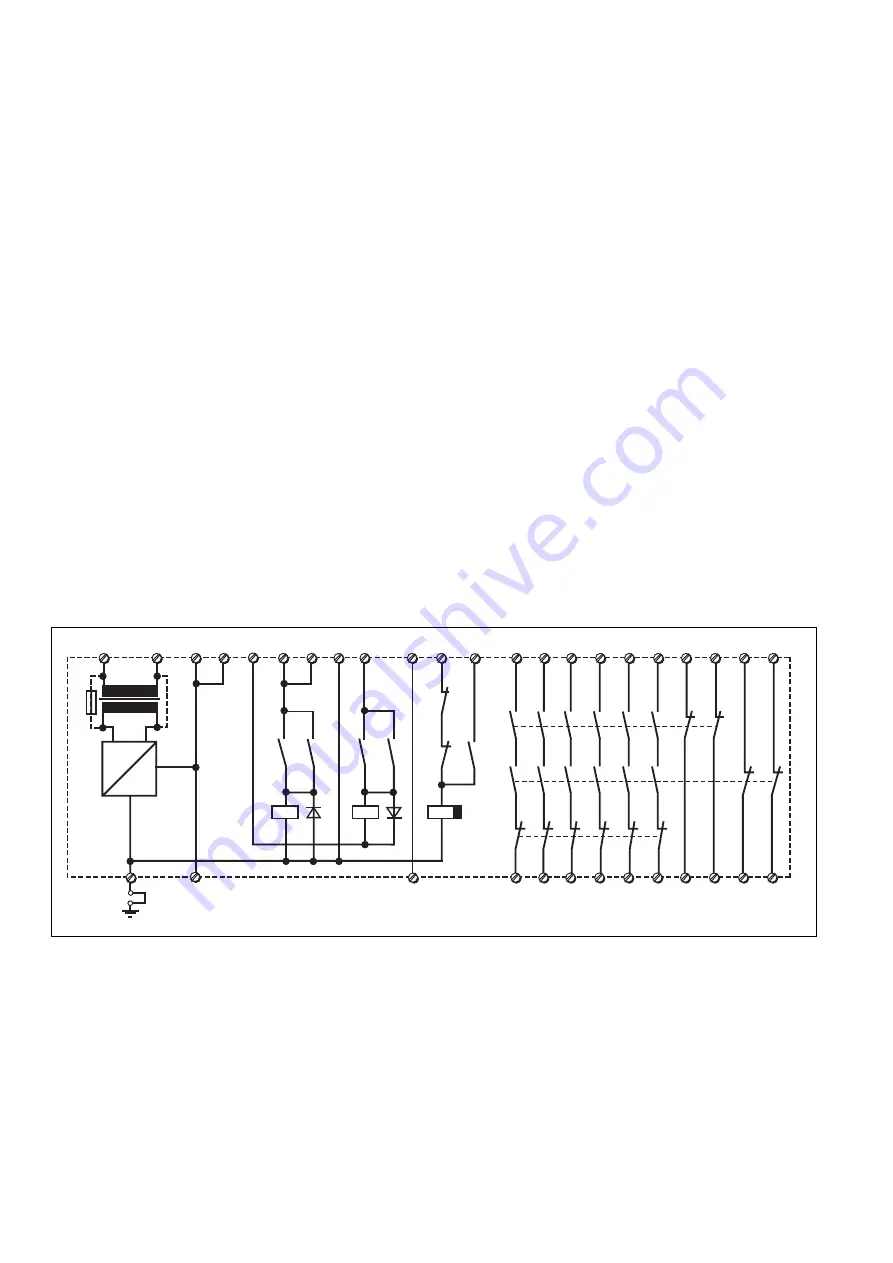
- 2 -
Funktionsbeschreibung
Das Schaltgerät PNOZ X10.1 dient dem
sicherheitsgerichteten Unterbrechen eines
Sicherheitsstromkreises. Nach Anlegen der
Versorgungsspannung leuchtet die LED
"Power". Das Gerät ist betriebsbereit, wenn
der Rückführkreis Y1-Y2 und der Startkreis
S33-S34 geschlossen sind.
• Eingangskreis geschlossen (z. B. Not-
Halt-Taster nicht betätigt)
Die LEDs "CH.1IN" und "CH.2IN"
leuchten. Relais K1 und K2 gehen über
die Schließer K3.1 und K3.2 in Wirk-
stellung und halten sich selbst über K1.1
bzw. K2.1. Die LEDs "K1" und "K2"
leuchten. Durch Öffnen der Öffnerkon-
takte K1.2 und K2.2 geht K3 nach Ablauf
der Rückfallverzögerung in Ruhestellung.
Die Sicherheitskontakte (13-14/23-24/33-
34/43-44/53-54/63-64) sind geschlossen,
die Hilfskontakte (71-72/81-82/91-92/01-
02) sind geöffnet.
• Eingangskreis wird geöffnet (z. B. Not-
Halt-Taster betätigt)
Die LEDs "CH.1IN" und "CH.2IN"
erlöschen.K1 und K2 fallen in die
Ruhestellung zurück.
Die LEDs "K1" und
"K2" erlöschen. Die Sicherheitskontakte
(13-14/23-24/33-34/43-44/53-54/63-64)
werden redundant geöffnet, die Hilfs-
kontakte (71-72/81-82/91-92/01-02)
geschlossen.
Start mit Überwachung (Taster im
Startkreis und Y1-S37 geschlossen)
Bei Betätigen des Starttasters zieht Relais
K3 an und hält sich selbst. Die LED "K3"
leuchtet. Erst nach Loslassen des Start-
tasters ist das Gerät betriebsbereit. Relais
K3 fällt ab
und die LED "K3" erlischt.
S11
13
23
33
71
14
24
34
72
K2
K1
K3
K2.2
K1.2
Y1
Y3
K3
+
~
=
F1
G1
S34
S33
K3.1
K3.2
S12
S12
S22
K2
K2.1
K1
A2 (L-)
A1 (L+)
K1.1
U
B
*
43
44
53
54
63
64
81
82
91
01
92
02
S11
S21
Y2
S37
K3
Fig. 1: Innenschaltbild/Internal Wiring Diagram/Schéma de principe
Description du fonctionnement
Le relais PNOZ X10.1 assure de façon sure,
l’ouverture d’un circuit de sécurité. A la mise
sous tension du relais (A1-A2), la LED
"Power" s'allume. Le relais est prêt à
fonctionner si la boucle de retour Y1-Y2 et le
circuit de réarmement S33-S34 sont fermés.
• Fermeture des canaux d’entrée
(par ex. AU non actionné) :
Les LEDs "CH.1IN" et "CH.2IN" sont
allumés. Les relais K1 et K2 collent par
l’intermédiaire des contacts K3.1 et K3.2 et
s’auto-maintiennent par K1.1 et K2.1. Les
LEDs de visualisation "K1" et "K2" sont
allumées. L’ouverture des contacts K1.2 et
K2.2 fait retomber le relais K3. Les
contacts de sortie de sécurité (13-14/23-
24/33-34/43-44/53-54 et 63-64) se
ferment, les contacts d’information 71-72/
81-82/91-92 et 01-02 s’ouvrent.
• Ouverture des canaux d’entrée (par ex.
action sur AU):
Les LEDs "CH.1IN" et "CH.2IN"
s'éteingnent. K1 et K2 retombent. Les
LEDs de visualisation "K1" et "K2"
s'éteingnent Les contacts de sortie (13-14/
23-24/33-34/43-44/53-54/63-64) s’ouvrent
de façon redondante, les contacts
d’information (71-72/81-82/91-92/01-02)
se ferment.
Surveillance du poussoir de réarmement
(pontage des bornes Y1-Y37)
Une action sur le poussoir de réarmement fait
monter le relais K3 qui s'auto-maintient. La
LED "K3" s'allume. Le PNOZ X10.1 n'est
activé qu'au relâchement du poussoir de
réarmement. Le relais K3 retombe. La LED
"K3" s'éteint.
Modes de fonctionnement
• Commande par 1 canal: conforme aux
prescriptions de la EN 60204-1, pas de
redondance dans le circuit d’entrée, la
mise à la terre du circuit d’entrée est
détectée.
• Commande par 2 canaux: circuit d’entrée
redondant, la mise à la terre et les courts-
circuits entre les contacts sont détectés.
• Réarmement automatique : le relais est
activé dès la fermeture des canaux
d’entrée.
• Réarmement manuel: le relais n’est activé
qu’après une impulsion sur un poussoir de
validation.
• Surveillance de circuit de réarmement: le
relais n'est activé qu'après le relâchement
du poussoir de validation.
Function Description
The PNOZ X10.1 provides a safety-oriented
interruption of a safety circuit. After the
operating voltage is applied, the “Power” LED
is on. The unit is ready for operation if the
feedback control loop Y1-Y2 and the reset
circuit S33-S34 are closed.
• Input circuit closed (e.g. emergency stop
button not pressed):
The LEDs “CH.1IN” and “CH.2IN” are on,
relays K1 and K2 energise via the N/O
K3.1 and K3.2 contacts and maintain
themselves via K1.1 or K2.1. The LEDs
“K1” and “K2” are on. If the N/C contacts
K1.2 and K2.2 open, K3 de-energises
following a delay-on de-energisation. The
safety contacts (13-14/23-24/33-34/43-44/
53-54/63-64) are closed, the auxiliary
contacts (71-72/81-82/91-92/01-02) are
opened.
• Input circuit opened (e.g. emergency stop
button activated):
The LEDs “CH.1IN” and “CH.2IN” go out,
K1 and K2 de-energise to the reset
position. The LEDs “K1” and "K2” go out.
The safety contacts (13-14/23-24/33-34/
43-44/53-54/63-64) are opened
redundantly, the auxiliary contacts (71-72/
81-82/91-92/01-02) are closed.
Reset with monitoring (Button in reset
circuit with Y1-S37 closed)
By pressing the reset button, relay K3
energises and retains itself. The LED “K3” is
on. Only after releasing the reset button is
the unit ready for operation. Relay K3 de-
energises and the LED “K3” goes out.
Operating Modes
• Single-channel operation: Input wiring
according to EN 60204-1, no redundancy
in the input circuit, earth faults are
detected in the emergency stop circuit.
• Two-channel operation: Redundancy in the
input circuit, earth faults in the emergency
stop circuit and shorts across the emer-
gency stop pushbutton will be detected.
• Automatic reset: Unit is active as soon as
the input circuit is closed.
• Manual reset: Unit is only active when a
start button has been pressed.
• Manual reset with monitoring: Unit is only
activated, when the reset button is pressed
and then released.
Betriebsarten:
• Einkanaliger Betrieb:
Eingangsbeschaltung nach VDE 0113 und
EN 60204-1, keine Redundanz im Ein-
gangskreis, Erdschlüsse im Tasterkreis
werden erkannt.
• Zweikanaliger Betrieb: Redundanter Ein-
gangskreis, Erdschlüsse im Tasterkreis
und Querschlüsse zwischen den Taster-
kontakten werden erkannt.
• Automatischer Start: Gerät ist aktiv, sobald
Eingangskreis geschlossen.
• Manueller Start: Gerät ist erst dann aktiv,
wenn ein Starttaster betätigt wird.
• Manueller Start mit Überwachung: Gerät
ist erst aktiv, wenn der Starttaster betätigt
und wieder losgelassen wurde.


























